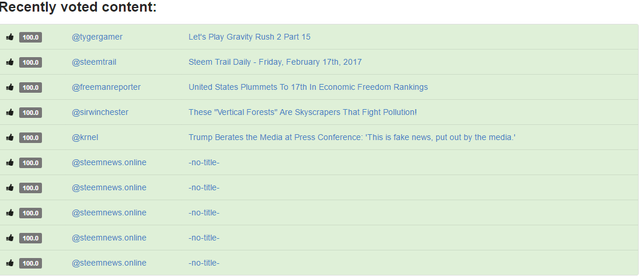Steemit: Liquid Democracy for Social Media
When people think 'liquid democracy', they think about politics and decision-making. Steemit, however, offers an opportunity to expand the concept into social media.
A liquid democracy is touted as democracy for the 21st century. Combining the best elements of direct democracy and representative democracy, a liquid democracy allows people to delegate their votes to a proxy who votes on issues for them -- but individual voters are also free to withdraw their votes from the proxy if they feel the proxy is voting against their wishes.
This video provides a fuller explanation of the term:
Individual Steemians are free to upvote or flag any post at will. They may create bots to automate the voting process, or delegate their votes to curators. Guilds have their own systems of discussing which posts to upvote or flag. Instead of deciding on policy, though, Steemians collectively decide and reward what they believe is the best content on Steemit.
Lessons for Liquid Democracy

I can vote, you can vote, everybody can vote!
As a model for real-world applications of liquid democracy, Steemit has much going for it. People are rewarded for participating in the platform with tokens that can be exchanged for real currency, incentivising future participation. Instead of outright censoring controversial material, people can simply ignore the post and the writer; the lack of payment tells the writer what the marketplace of ideas really thinks of his content. For abusive content, voters can hide the content through coordinated flagging ('nuking'). This will not make the content disappear, but flagging does massive damage to the user's reputation, signalling him to either shape up or get out. And if a rogue users abuse the flagging, other accounts exist to counter these flags.
Steemit is a user-driven platform. Solutions are organically developed from the ground-up. Instead of relying on the mercies of an unaccountable development team, Steemians are free to identify and resolve issues through the platform's tools where possible. The blockchain prevents content from being arbitrarily removed -- at least not without someone noticing -- which defeats attempts at government censorship. Unlike other social media platforms like Facebook, Twitter or Reddit, where censorship of dangerous ideas is celebrated, the hand of the dev team or moderators is little-felt at the day-to-day levels.
Social media doesn't translate cleanly into policymaking. But there are three key lessons from Steemit that apply to liquid democracy.
The first is user empowerment. Steemit is designed around the user, empowering and incentivising participation in the platform. While Steemit's model allows for weighted votes, in a state or organisation run by liquid democracy every user should only have one vote. This prevents powerful oligarchs from dictating terms to the rest of the nation. However, in a liquid democracy, people are free to delegate that vote to proxies, as in the case of Steemians empowering curation guilds to curate posts on their behalf. This frees people from the need to invest enormous amounts of time and energy into researching topics, and creates opportunities for people with the ability to do so to rise from the crowd. At the same time, voters are also free to vote according to their conscience instead of delegating their vote to a proxy who may not be aligned with their beliefs.
The second is protection of the marketplace of ideas. For a liquid democracy to work, free and fair debate is critical. All ideas must be allowed to participate in the marketplace of ideas, no matter how heinous they may seem to people. Censorship destroys and distorts the marketplace, driving targeted ideas underground but not obviating them. On Steemit, people are free to engage or ignore poor content and conceal abusive ones through flagging; in a liquid democracy, citizens should likewise be free to defeat bad ideas in the cut and thrust of debate, or simply ignore bad ideas into oblivion. The only place for censorship in a liquid democracy is to guard against a greater harm, such as preventing the disclosure of details of a criminal investigation.
The last lesson is decentralisation and division of labour. Nobody can be an expert at everything. In Steemit's larger curation guilds, different subgroups handle specialised subjects. Steemtrail, for example, has multiple trails dedicated to topics like alternative energy, beer or fiction, operated by curators interested in them. Likewise, in a liquid democracy, political parties may form different subgroups to become the face of the party on topics like the economy, national security and so on. This allows political parties to deploy the best candidates to handle specific issues. While each subgroup would drive the party's policy with respect to their area of focus, other party members are also free to join in if they are willing and/or qualified to do so. Party members and ordinary voters are free to delegate their votes to these experts. But they are also free to delegate their votes to someone else, or vote directly on the subject. This approach allows everybody's views to be represented, while creating the environment for subject matter experts to tackle issues they are qualified for.
Lessons for Steemit

Sometimes, you have to be that guy.
Steemit also has a major lesson to learn from liquid democracy: transparency.
In a liquid democracy, proxy voting is supposed to be completely transparent. This ensures voters know how their proxies will vote. The proxy's voting behaviour is also recorded, letting voters check the proxy's voting record. Blockchain technology makes this possible by creating a permanent record of a proxy's voting behaviour and how he intends to vote in the future. Politicians and proxies can count on the media to tell the world where they stand on certain topics and why. Steemit doesn't offer the same capability.
Users normally trust curation guilds to vote in line with their tastes, but this may not always be so. Using Streemian, users may empower curators to vote on their behalf -- up to a point. They may require the curator to vote on certain topics with specific tags, like writing or fiction, or to deny the curator the ability to vote on posts with other tags. This allows users to decide just how much power they wish to give curators. But even this is not sufficient. Here are two examples.
Alice wishes to promote science content on Steemit, so she requires her favourite curator to vote on posts tagged 'science'. The curator follows her wishes by voting on all posts with that tag -- even posts that contain erroneous facts or psuedoscience disguised as proper science.
Barry decides that he will vote on all police-related content himself, so he prevents his curator from voting on posts tagged 'police' and 'crime'. The curator then upvotes and resteems a specific post that makes a false allegation of police brutality. Barry knows for a fact that this allegation is false and would not have upvoted or resteemed it. But as that post is tagged only as 'writing' and 'blog', Barry's wishes are not acceded to. He only discovers the curator's actions only when that post appears on his feed -- and wonders what else the curator has voted on without his permission.
Users, curators and writers may do their best, but there will always be gaps not covered by filters. When faced with such scenarios, the easy option is to simply shrug and let the vote stand. Nobody is harmed by the upvote, so why bother? Besides, the user stands to gain curation rewards, and rescinding the vote will reset them.
However, the blockchain makes no distinction between curator and user. A curator may vote on behalf of a user, but on the blockchain the vote is recorded as originating from the user. A person cannot in good faith be expected to be recorded as having voted for a post that goes against everything he stands for, especially since with every vote drains an account's voting power, reducing the curation reward. Further, should a curator choose to flag a post, there will be negative repercussions for the targeted user. Should a user believe that the target is not guilty, he should be free to cancel his own flag.
In a liquid democracy, every vote belongs to the user, to be given away or taken back as he sees fit. For a direct democracy to work, proxies must be transparent. Their votes and rationale for the votes must be known to all.

As we can see here, Streemian doesn't do a good job in making votes transparent. The user must first log into Streemian, go to the curator trail and select a specific curator before he can see the voting history. And even that, that history is limited to the last ten votes. This is troublesome for a user, and inadequate.
Going forward, Steemit should introduce measures to enhance curator transparency. At any time, Steemians should be able to quickly access a curator's voting record with a minimum of clicks, either in Steemit proper or on a third-party platform. The voting record should cover the curator's history for at least the past twenty-four hours. Curators should justify every vote they make on the public record. When examining the record, users may choose to filter the record by tags for easier reading. Should they discover that a curator has voted against their interests, users are free to cancel their vote at any time. And of course, if a user feels a curator is no long aligned with his interests, he is free to drop the curator and vote manually. Finally, if the platform allows it, users should have the option of recording curator-delegated votes on the blockchain as such (i.e. User delegated Curator to upvote Post X) to distinguish them from manual votes.
Social Media for the 21st Century
Going forward, Steemit is primed to revolutionise social media. It natively encourages users to invest in the platform for the long-term through cryptocurrency. Through the adoption of the blockchain and empowerment of curators, Steemit is now a social media platform that runs along principles of liquid democracy. Steemit's main stumbling block is lack of curator transparency, underscoring the importance of proxy transparency for policymaking. Should this obstacle be overcome, Steemit could serve as a model for the political evolution of democracies.
The new delegated steem power feature coming in hard fork 17 will make it possible to delegate to a guild but have the guild members held responsible for the vote.
Additionally, each user that allows the guild to vote today can do so by giving them a dedicated key or adding the account as a co-signer. This means there is proof on the blockchain (even today) of who did what in the name of whom.
Sounds like an excellent feature.
Hello @cheah,
Congratulations! Your post has been chosen by the communities of SteemTrail as one of our top picks today.
Also, as a selection for being a top pick today, you have been awarded a TRAIL token for your participation on our innovative platform...STEEM.
Please visit SteemTrail to get instructions on how to claim your TRAIL token today.
If you wish to not receive comments from SteemTrail, please reply with "Stop" to opt out.
Happy TRAIL!

Hi @cheah, I just stopped back to let you know your post was one of my favourite reads yesterday and I included it in my Steemit Ramble. You can read what I wrote about your post here.
Thanks for the mention! Appreciate your write-up.
I'm a bit confused. What is the difference between a curator and a user in this context?
A user is a regular Steemian like you and me.
A curator is an account (either a person or a group) that curates content, and is authorised to upvote and/or flag content by a user.
Then what is the difference between a user's upvote and a curator's upvote?
When a user upvotes a post, it counts as one upvote.
When a curator upvotes a post, his vote is combined with all the users who have authorised him to vote on his behalf. So if a curator has a hundred people in his trail, each upvote is counted as 101 upvotes (the 101st is his). [At least, that's if I'm recalling the mechanism properly.]